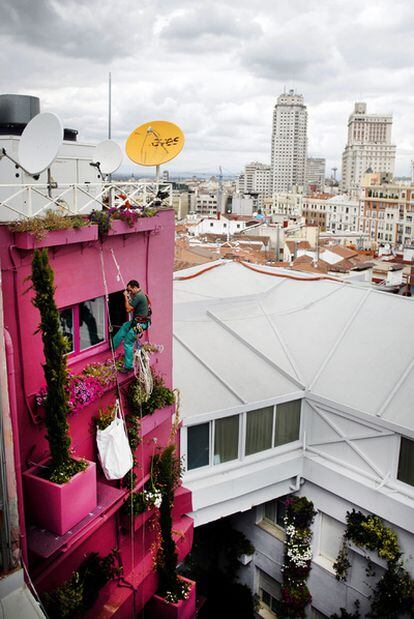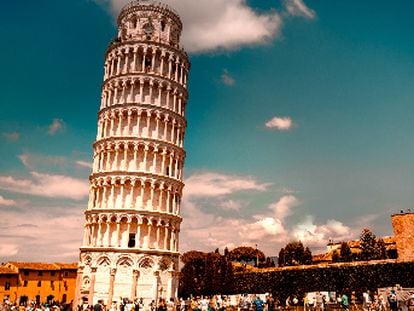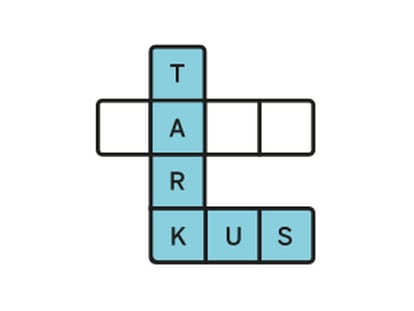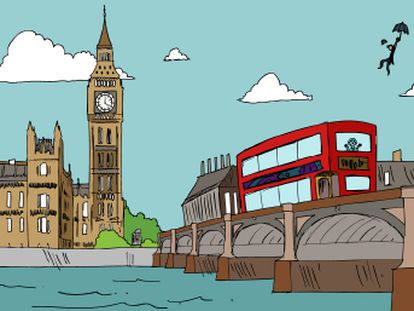Time to tend the skyline: Madrid's hanging gardens
Looking up at the capital's imaginative solutions to a shortage of greenery
Madrid has never been a city celebrated for its parks and gardens, with greenery a rarity in its densely packed streets. But as French botanist Patrick Blanc points out, "The horizontal spaces may be all taken, but the vertical is still unoccupied."
Blanc is credited with inventing the modern-day hanging garden, and his work can be found throughout Europe's major cities. In Madrid, Blanc's creations grace the CaixaForum arts center in the downtown area, close to the Prado Museum, as well as on the fiftieth floor of the Crystal Tower, one of the four skyscrapers that dominate the Madrid skyline a couple of kilometers down the road to the north of the city center.
The capital's latest perpendicular park is to be found within the Hotel Santo Domingo, just off the central thoroughfare of Gran Vía. It covers a 23-meter-high wall in an interior patio, around the size of two tennis courts.
"We wanted guests in interior rooms to have something nice to look out on"
"At 40 degrees, if the system fails, the plants can be dead in three hours"
"We call it hanging, because it is built on scaffolding, with the plants in rows, growing in earth, as they would normally," says Clara Vivar, the hotel's spokeswoman. Blanc's approach is different: he uses a PVC structure that is then covered with a synthetic felt into which the plants then root.
"Our inspiration was the hanging gardens of Babylon," says Vivar. "We wanted guests in the interior rooms to have something nice to look out on."
The wall garden is home to more than 2,500 plants from more than 110 species, as well as a 20-meter waterfall and cypresses standing almost six meters tall.
"The use of lots of different species is important, because it keeps disease down," says agronomist and landscape artist Manuel Pasquín, who worked on the creation and design of the hotel garden. He adds that selecting plants for the capital was not easy, as anyone who has tried a pot of gardening in central Spain will know all too well. "Madrid has a harsh climate, with cold winters and very hot summers; the best thing is to work with plants from this area, or from others with similar characteristics."
"You never know which plants will take to a wall zone," adds Blanc. These are living systems, and we are finding out how they work as we go along," he explains. The Frenchman prefers to use perennial plants to create their own intertwined eco-system, whereas the flowers in Pasquín's garden will be changed for each season. "Right now we have a summer garden, with brightly colored begonias and margaritas, as well as pansies, which not only come in many colors, but can resist cold temperatures."
The main challenge, he says, is keeping the plants properly watered. "The soil is very fine, and in summer we have to water up to 15 times a day," says Pasquín. "At 40 degrees, if the system fails, the plants can be dead in three hours."
The CaixaForum garden, which was opened in February 2008, has taken root, attracting its own mini-wildlife in the form of butterflies. But Blanc has gone much further with his latest project in the Crystal Tower, which covers some 600 square meters and has some 24,000 plants, and can now be seen illuminated at night from the ground.
"The garden is representative of El Escorial, not Madrid," says María Luisa Correas, a spokeswoman for the owners of the building. She says that the most difficult part of creating the garden was planting the evergreen holm oaks typical of the mountains 60 kilometers north of Madrid.
Like their horizontal counterparts, vertical gardens also make a contribution to cleaning up the atmosphere, trapping carbon dioxide, emitting oxygen, and keeping temperatures stable. The Hotel Santo Domingo garden will absorb 25,000 kilograms of carbon dioxide each year and has the same cooling effect as 50 air conditioning machines. It also offers a refuge for wildlife: sparrows, a familiar Madrid resident, have already begun nesting.











































































